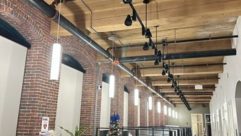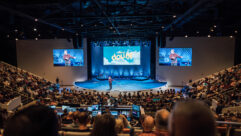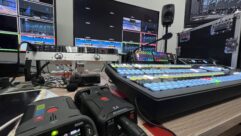
Multi-zone Sound System for Traditional Church, Part 2
Jul 19, 2012 10:41 AM,
With Bennett Liles
Listen to the Podcasts
Editor’s note: For your convenience, this transcription of the podcast includes timestamps. If you are listening to the podcast and reading its accompanying transcription, you can use the timestamps to jump to any part of the audio podcast by simply dragging the slider on the podcast to the time indicated in the transcription.
The Westminster Presbyterian Church in Minneapolis was built long before sound or video systems existed and AVE of Maple Grove Minnesota was called in to add sound and video while maintaining the church’s traditional look and feel. Kevin Crow of AVE is back to give us the details on the video system that AVE installed, coming up next on the SVC Podcast.
SVC: Kevin Crow from AVE in the Twin Cities area of Minnesota, thanks for being back with us for part two on the Westminster Presbyterian Church sound and video upgrade you did there. A new sound system with iPad control that we talked about in part one. What we didn’t talk about earlier was the video system and to sort of set the stage for that, what’s the technical crew situation at the church? Do they have a permanent crew or is the system pretty much on its own?
Kevin Crow:They have a couple of staff members that run sound and video, and then they have a couple of volunteers that do the same as well. On the video side they have a couple of volunteers that work the cameras and take care of the recording and the streaming. [Timestamp: 1:27]
OK, so you have to make this system operate as simply as possible. One of the interesting video things is the video monitoring for the organist. How did you set that up?
This was actually a project that we did several years ago for them. The organist is not able to see from her vantage point when the pastor is ready to go and walks up to the pulpit mic, so we put in a small very inexpensive camera. I believe it’s just a Canon, and we give her a little LCD monitor so she can see when the pastor walks up. It’s a very neat feature that we’ve done at quite a few churches actually. [Timestamp: 2:02]
Yeah, that would be a handy thing for the organist because they have to take a lot of visual cues during a service.
Yeah many times the organ consoles are very, very large too so they block a lot of the view. [Timestamp: 2:11]
So what else did they want to do in expanding their video capability?
AVE has really been leading the charge when it comes to web streaming with a lot of our clients or at least we’re always talking about it with them because it’s just such a huge opportunity right now when it comes to reaching people that can’t attend the church. You got to think about all the shut-ins, elderly people that can’t make it to church any more; there’s people that go on vacation; there’s people that stay out of town during certain times of the year—that’s a big deal up here in the Twin Cities in the winter—it’s very cold up here. So they were really receptive to that and we were able to work in a very, I think, a very practical and good video package to do web streaming and they love it. [Timestamp: 2:52]
Yeah, that would give them a big advantage in keeping the big church family together. And you’ve got another feed going into another building or another part of the building?
Another part of the building, yes. So they have a fellowship hall, I believe it’s called the Great Hall, and we are sending the program feed that goes to the stream and to the recording—they’ve got DVD recording as well. We’re sending that same image with audio down to another room so that if people are preparing food or if they’re in that room for overflow—the church actually packs out at Christmas and Easter so they need a pretty large overflow room and they’ve got flat panel displays that we added in that room so that they can do overflow and get a nice program feed from the camera system. [Timestamp: 3:34]
And I think you went with PTZ cameras since they don’t have a full-time crew. What kind of PTZ cameras did you put in there?
One of the biggest challenges with churches with cameras is if you try to go the tripod route they take up so much physical real estate so not only is it an operator, it simplifies the number of operators that you need and reduces it but it’s also physically less obstructive in the room so we chose Vaddio’s line of handheld cameras, the HD-19, and it is an excellent high definition camera. We are running the whole system at 720p and then we just down convert to SD for the stream but otherwise the whole system is a high def 720p system right now. [Timestamp: 4:14]
And where is the control point for the cameras? Who operates it?
Vaddio makes a product called the ProductionVIEW HD. It can control up to, I believe, six or eight cameras and it can save presets so you can set up camera positions and just hit preset recall. It also integrates with the CCU units that are in the rack and it is all in the churches’ sound booth next to the sound equipment. [Timestamp: 4:38]
OK so out of sight and I guess pretty much out of mind of most of the congregation.
Yeah, it’s in the sound booth—I don’t know why they call it a sound booth still because it is really more a video control booth. They’ve got the iPad for sound control so it’s located in the very back balcony upper back area and most people don’t even know it’s there so. [Timestamp: 4:56]
When you were installing all the cameras obviously there was control cable and video lines to run. Were there any architectural obstacles or anything with that?
You know they had a decent access point and some conduit from the remodel project in the 90’s that we were able to use so it wasn’t too difficult in that respect. The Vaddio cameras, one of the big feature points is that you can use structured wire so you don’t need to use larger coax or anything like that. It’s all twisted pair to and from the cameras and that’s what we used for the project. [Timestamp: 5:26]
OK and I think you touched on this before. What video format are you using to distribute the signal?
So we have a Kramer component video DA in the booth that splits 720p to all the devices so the DVD recorder, the streambox—they’ve got a Roland Encoder streambox. I believe that the model’s a VC-30 and all of the stuff gets a 720p image—the Great Hall all of it. [Timestamp: 5:53]
And I think you mentioned that they’ve got LCD screens for video monitoring in the Great Hall rather than projection.
They’ve got, I believe, 52 in. LG commercial LCD screens in that room. [Timestamp: 6:04]
OK, less maintenance and no lamps to change.
No lamps on projectors—all that. They do have a projector plug in point that they can use in the so if they want to take it into a projector for a larger screen they can do that. [Timestamp: 6:15]
So how do they hear the sound in the Great Hall over there?
We’re actually using a Volante system which is it’s HD and audio over IP so not only can they do it in the Great Hall but they can expand in future and grab the audio by buying more Volante boxes and just use the churches existing structured wire. [Timestamp: 6:32]
Well, it sounds like a system that can be expanded and adapted for whatever comes up and I’m sure they were impressed with it so after it got its first test run did you have to go in and make any tweaks to anything?
Not really so much on the video side. We did have to adjust the video white balancing and the color balancing on the cameras. That took a little bit of work. We also had to do modifications to how we were encoding it to the streaming service so AVE re-sales the streaming service to churches called Worshipstream.com and it’s an ad free service meaning there is no advertising on the stream next to it. They just pay a monthly fee and they’re able to stream and then once the stream happens it auto-archives on a streaming channel so the church has a streaming channel with all the old sermons on it that you can just click on and it also has a live button on their website as well. [Timestamp: 7:22]
I’m sure it made a huge difference in their services not only for speech intelligibility but the addition of the streaming was a big advantage. You got that one done so what’s coming up for AVE? Got any projects you want to tell us about?
Yeah, we’re actually really busy. What we’re most excited about is the ability to do what we do outside of the Twin Cities, so last year we put in about a—about a $100,000 sound system at a church in Santa Fe, N.M., a very difficult cathedral style church—probably 5-6 second reverb time room. We were able to do a digitally steerable line array in Santa Fe, N.M. Just a couple of weeks ago we did full sound video, lighting, and acoustics project at a church in Salt Lake City, Utah, so AVE is expanding nationally and is doing jobs all over the country now not just in the Twin Cities. [Timestamp: 8:11]
How many people have you got on staff there? That sounds like you’ve got yourself a handful.
Yeah, it’s been a hard past three years with the economy, but we are back to about 17 employees where we were back in 2007 so that’s a good thing. [Timestamp: 8:24]
OK, well it sounds like things are looking up and thanks for being here to give us the details on this one. Kevin Crow from AVE in Minneapolis and the sound and video project at the Westminster Presbyterian Church. Thanks again for being here.
You’re very welcome Bennett. Thank you.










